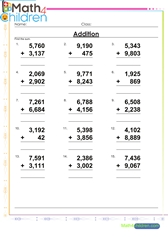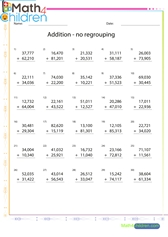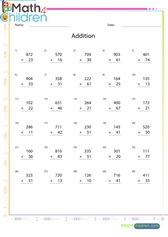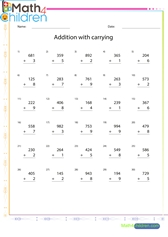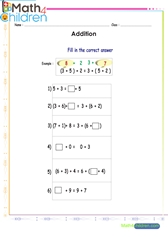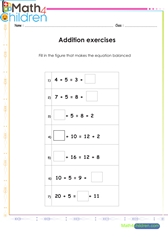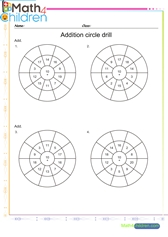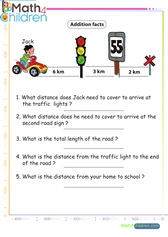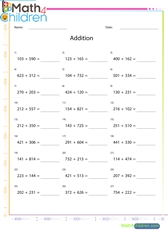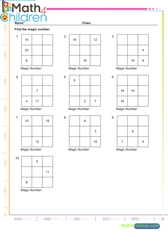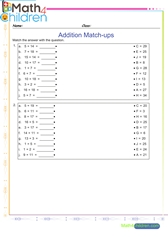![]()
Mixed Addition and Subtraction with Regrouping
Mixed addition and subtraction with regrouping is a fundamental mathematical concept that involves performing both addition and subtraction operations while dealing with numbers that require regrouping. This technique is essential for solving complex mathematical problems efficiently and accurately.
Additio of 5 plus 5 digit numbers
Additio of 5 plus 5 digit numbers printable math worksheet
Addition and balancing equations
Addition and balancing equations printable math worksheet
Addition horizontally arranged numbers
Addition horizontally arranged numbers printable math worksheet
Subtraction of numbers with regrouping game
Understanding Addition with Regrouping
Understanding addition with regrouping, also known as carrying, is a fundamental concept in arithmetic that helps students deal with sums that exceed the value of a single digit in any given place value. This method is particularly useful when adding large numbers. Let's break it down step by step:
What is Regrouping?
Regrouping is the process of rearranging the distribution of numbers across different place values to make addition easier and more systematic. It involves carrying over values from one column to the next in an addition problem.
Why Regroup?
When the sum of the numbers in a column exceeds 9, we need to regroup because each position in a place value system can only hold a single digit, from 0 to 9. Exceeding this range requires us to move to the next higher place value.
Step-by-Step Guide to Addition with Regrouping
Let's add two numbers as an example: 456 + 378.
-
Write the Numbers: Align the numbers vertically, ensuring that the ones, tens, and hundreds are lined up.
markdown456 + 378 ----- -
Add the Ones: Start by adding the rightmost digits (ones). 6 + 8 = 14. Place the 4 in the ones place and carry the 1 (representing 10) to the tens column.
markdown456 + 378 ------ 14 (4 in the ones place, carry over the 1 to the tens place) -
Add the Tens: Add the tens digits along with the carried number. 5 (from 456) + 7 (from 378) + 1 (carried over) = 13. Write down the 3 in the tens place and carry the 1 (representing 10) to the hundreds column.
sql456 + 378 ------ 134 (3 in the tens place, carry over the 1 to the hundreds place) -
Add the Hundreds: Add the hundreds digits along with the carried number. 4 + 3 + 1 = 8. Write the 8 in the hundreds place.
diff456 + 378 ------ 834 -
Result: The sum of 456 and 378 is 834.
Tips for Practicing
- Use Place Value Charts: Place value charts can help visualize the process of regrouping.
- Practice with Base-10 Blocks: These can be a great visual aid to understand the concept of regrouping.
- Start with Smaller Numbers: Begin with simpler problems to build confidence before moving to larger numbers.
By practicing these steps and understanding the concept of regrouping, students can efficiently tackle addition problems involving larger numbers, laying a strong foundation for more advanced arithmetic.
Understanding Subtraction with Regrouping
Subtraction with regrouping, also known as borrowing, is necessary when the digit being subtracted is larger than the digit it is being subtracted from. It involves borrowing from the next higher place value to make the subtraction possible.
Mixed Addition and Subtraction with Regrouping: Methodology
To tackle mixed addition and subtraction problems with regrouping, one needs to follow a systematic approach. This involves identifying the operation required for each step and applying the appropriate regrouping technique when necessary.
Benefits of Teaching Mixed Addition and Subtraction with Regrouping
Teaching mixed addition and subtraction with regrouping offers numerous benefits. It enhances students' problem-solving skills, promotes critical thinking, and fosters a deeper understanding of mathematical concepts. Moreover, it equips students with essential skills for real-world applications, such as managing finances and analyzing data.
Common Challenges and How to Overcome Them
Despite its importance, students often face challenges when learning mixed addition and subtraction with regrouping. These may include difficulty understanding the concept of regrouping or making computational errors. To address these challenges, educators can incorporate hands-on activities, visual aids, and interactive exercises to reinforce learning and provide additional support to struggling students.
Importance of Practice and Reinforcement
Practice plays a crucial role in mastering mixed addition and subtraction with regrouping. Regular practice through worksheets, exercises, and interactive games helps reinforce learning, build fluency, and increase confidence in solving complex mathematical problems.
Conclusion
Mixed addition and subtraction with regrouping is a fundamental skill that empowers students to solve mathematical problems effectively. By understanding the concepts and applying the appropriate techniques, students can enhance their problem-solving abilities and develop a strong foundation in mathematics.
FAQs
- Why is regrouping important in addition and subtraction?
- Regrouping allows us to perform calculations with larger numbers efficiently, ensuring accurate results.
- What are some common mistakes students make when learning regrouping?
- Common mistakes include forgetting to regroup, misplacing digits, and misunderstanding the concept of borrowing and carrying.
- How can parents help their children practice mixed addition and subtraction with regrouping at home?
- Parents can provide support by using everyday situations as opportunities to practice regrouping, incorporating fun activities, and providing encouragement and positive reinforcement.
- Are there any online resources available for practicing mixed addition and subtraction with regrouping?
- Yes, there are numerous online platforms offering interactive games, worksheets, and tutorials to help students practice and reinforce their regrouping skills.
- At what age should children start learning mixed addition and subtraction with regrouping?
- While the exact age may vary, children typically begin learning regrouping techniques in elementary school, usually around second or third grade.
Short Subtraction Tutorial

